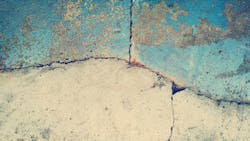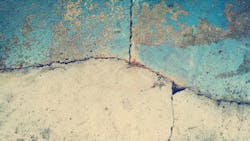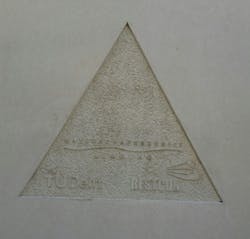Self-Healing Concrete In The Netherlands
Dutch utility Waterschapsbedrijf Limburg has converted a treatment plant into a full size laboratory to test new technologies and materials. This includes a self-repairing concrete tank. As a world first, how does this work and what potential does it have to reduce operation and maintenance costs?
By Andrew Williams
Fixing cracks in concrete water and wastewater tanks is an unavoidable - not to mention difficult, time consuming and often very costly - activity. When coupled with the added complications associated with draining tanks before repairs can be carried out, as well as the extra costs inevitably incurred when treatment facilities are shut down, such tasks can soon turn into a considerable burden on businesses and the bottom line.
In an interesting attempt to tackle these ongoing challenges, Netherlands based water utility Waterschapsbedrijf Limburg (WBL) has now embarked on an innovative pilot project involving the construction of the first ever wastewater treatment tank made partly from self-repairing concrete. So, what exactly does the pilot project entail? What are the actual and potential applications of self-healing concrete in the wastewater storage and treatment sector? And what impact could the new material ultimately have on tank maintenance and repair costs?
Self-healing material
In an effort to develop next generation wastewater storage and treatment methods, the Dutch outfit has taken the bold step of transforming a large part of its Simpleveld plant in the southern Netherlands into a full size laboratory designed to act as a test bed for groundbreaking and pioneering wastewater technologies, as well as state of the art modular facility construction techniques. As part of this initiative, three of around thirty wall elements in a prefabricated wastewater tank have been constructed from a cutting edge type of self-repairing concrete.
If cracks occur in the concrete, calcite-precipitating bacteria embedded in the novel ‘self-healing’ material - developed in collaboration with TU-Delft (Delft Technical University) - automatically produce lime to repair the damage, resulting in higher durability and lower repair and maintenance costs.
“TU-Delft has developed this innovative concrete by adding special bacteria to regular concrete,” says Karel Clemens, project development manager at WBL. “The bacteria that are applied are absolutely harmless to people and the surrounding environment.”
However, although self-repairing concrete is undeniably a very useful material, Clemens admits that it is currently more expensive than regular concrete. As a result, he explains that its application at this stage has been confined to a focus on structures that are “hard to reach for inspection and repair” - such as the wastewater tank at Simpleveld. To produce the concrete elements, Clemens also reveals that the WBL and TU-Delft team worked in close cooperation with the manufacturer of the tank, Bestcon - in the process proving that self-repairing concrete can be produced in any well equipped concrete products factory.
“This application of self-repairing concrete in a sewage treatment plant is a worldwide first. The pilot project aims to examine how self-repairing concrete in sewage acts when compared with traditional concrete. To this end, the concrete elements already placed will be regularly monitored in the coming years - and the first results are positive,” he says.
“If the lifecycle cost for tanks that are partly made out of self-repairing concrete turn out to be lower than that of traditional concrete tanks then the application of the material for new projects is certainly an option,” he adds.
Modular plant construction
The self-healing concrete pilot project forms part of a series of trailblazing wastewater treatment innovations being trialled at the Simpleveld plant. According to Clemens, three further large wastewater tanks have also been built from a variety of materials, including stainless steel, wood and coated steel - with the facility acting as a laboratory to test the relative merits and cost implications of each.
The trials are taking place under WBL’s new Verdygo brand - a spin out venture established chiefly to promote a novel technique for the design and construction of wastewater treatment facilities - heralding a bold new approach by the company’s top management.
Whereas wastewater around the world is typically purified by letting it trickle through a pre-set range of processes in a range of fixed tanks set permanently in the ground, Verdygo treatment plants rely instead on an innovative flexible and modular approach that enables the company to apply innovative processes more quickly and at a lower cost. In basic terms, the approach entails the construction and rapid positioning of a variety of standard sized modules above ground. Each module can also be reasonably easily disassembled and moved elsewhere - or connected to other modules or groups of modules to build a much larger system.
“With the Verdygo system, no wastewater is purified - instead purified wastewater is produced in the quality needed at the time and in the place where it is needed. By establishing decentralised cleansing near water users, the reuse of treated water is stimulated,” says Clemens.
“The Verdygo system has been developed for wastewater treatment plants with a capacity of between 10,000 and 100,000 population equivalents,” he adds.
Cost advantages
The results of the Simpleveld project are likely to be of strong interest to wastewater companies keen on assessing the relative merits of new materials, as well as to the broader self-healing concrete research and development community.
Dr. Kevin Paine, from the University of Bath’s civil engineering department believes that the main advantage of using self-healing concrete is that it should “reduce maintenance, inspection and repair operations” - which would clearly also result in a range of additional technological, operational and financial advantages.
In the coming years, Paine predicts that developers should be able to use self-healing concrete such as the type used in Simpleveld in much the same way as normal concrete - meaning that it shouldn’t affect constructability in any discernible way. Although he estimates that the initial cost of self repairing materials could be around 20% higher, Paine also expects the next generation of concrete - capable of “repeated self-healing events” - to have a lower whole life cost.
“I think the self-healing concrete at the wastewater treatment plant in Simpleveld and similar trials elsewhere, such as those carried out by the M4L team [in the UK], are vital,” he says.
“The construction industry is very risk averse - and justifiably so in many cases - and therefore while they do enjoy innovation they are keen to see where it has been used before. It is projects like this that are so vital to showing what can and can’t be achieved with new materials,” he adds.
Reduced maintenance requirements
Elsewhere, Bob Lark, professor of Civil and Materials Engineering at Cardiff University, believes that the key benefit of using self-healing concrete in wastewater treatment facilities is the reduced maintenance requirements.
“Concrete cracks for many different reasons and, however hard we try, making concrete watertight is a particularly difficult task. By using self-healing material we can let the material do the work for us whenever or however the cracking occurs,” he says.
In this light, he argues that the ultimate impact of self-healing concrete on wastewater tank maintenance and repair costs is potentially very significant - largely because its widespread use would mean that the industry would be “less reliant on identifying damage and the cost of repairing it”. Moreover, although he agrees with Paine in stressing the likelihood that self-healing materials will be more costly in the first instance, he is confident that their whole life costs will be significantly less - particularly if developers can achieve more than one self-healing cycle.
Lark also believes that the Waterschapsbedrijf Limburg and Verdygo project to use self-healing concrete at the wastewater treatment plant in Simpleveld is a very useful exercise.
“In our M4L project we have faced many challenges in scaling up the techniques that we have been developing.
“This project will enable the researchers to address similar challenges in relation to wastewater treatment plants and hence brings us closer to commercialisation and the deployment of such techniques more widely throughout our infrastructure,” he says.
Making concrete steps
Looking ahead, Lark also predicts that innovative new concretes and composite materials might soon be capable of carrying out a variety of functions in addition to self-healing - and may one day even be capable of self-diagnosing problems, or even “self-immunising” themselves.
“Currently what we have are materials that can self-heal themselves. What our new RM4L project will address is not only self-healing, but prior to this also self-diagnosis - that is, automatically recognising that healing is required without intervention - and self-immunisation, or preventing the damage from happening in the first place,” he says.
“We certainly hope that we will be trialling such materials within the next three years - and in many ways water retaining structures and infrastructure are some of the best applications for these techniques because many, including the bacteria being used by the Dutch group, rely on water to activate the healing mechanisms,” he adds.
Meanwhile, Paine reveals that, over the next few years, the RM4L team will be looking closely at the problem of repeated healing for elements that cyclically crack - perhaps due to regular seasonal changes - or that may become damaged more than once.
“We will be investigating the extent to which we can immunise concrete against harmful constituents - in the bio-mimetic sense this means looking at infections rather than just ‘wounds’ or cracks. We are also looking to develop materials that self-diagnose the extent of their ‘injuries’ and that self-control an appropriate response,” he says.
“I see the wastewater markets that are best suited to this technology being those which are difficult to access for repair - particularly those that are located underground - or where the effects associated with shutting down operations for maintenance would be prohibitive in terms of cost and other knock-on effects,” he adds.
Andrew Williams is based in the UK and is a freelance writer for WWi magazine.
More Water & WasteWater International Archives Issue Articles



